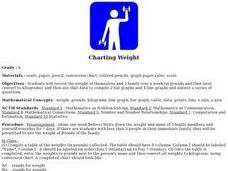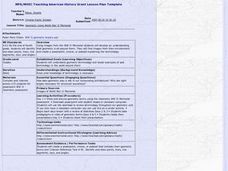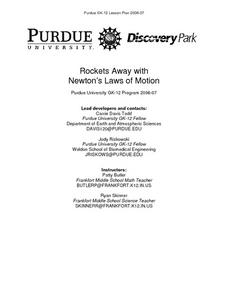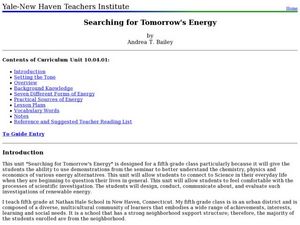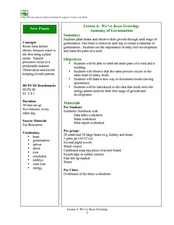Curated OER
Tri this Angle!
First graders draw and describe various types of polygons. they investigate their own environments for examples of polygons. After reading the book, The Greedy Triangle, they discuss everyday objects that are polygons. They create shape...
Curated OER
Pi Mathematics
Students will measure common everyday objects in order to calculate pi. In this measurement lesson plan, students measure the circumference and diameters of objects and fill them into a chart which helps them calculate pi.
Curated OER
Charting Weight
Sixth graders record the weight of themselves and 3 family over a week, and then use that data to compile 2 bar graphs and 4 line graphs and answer a series of questions.
Curated OER
Not Enough Drawers
Students describe three different categories to sort into. They sort these clothes into these three chosen categories. After asking questions the student divide the clothes.
Curated OER
Life with Energy
Students identify forms of energy and the advantages/disadvantages of different forms of energy. They describe ways in which technology affects the environment both good and bad. Finally, benefits are determines as well as the...
Curated OER
Surveying Our Media
Students participate in a lesson plan that is concerned with the concept of examining the use of media in society. They create surveys to measure the presence of the media in everyday life. The results are collected and represented in...
Curated OER
The Sum of the Parts
Second graders observe some everyday common objects in order to attempt to learn about simple systems and how they fit together. They observe small details in order to identify the parts of a whole design.
Curated OER
Generating and Recording Data
Students demonstrate their ability to collect, organize, and display data. They examine everyday objects that can be turned into a function machine for the lesson. They use colored fish to help them organize their data.
Curated OER
Geometry of The World War II Memorial
Students develop an appreciation of the use of geometry in our everyday world and structures. Students collect various picures and multimedia objcets that explain geometric principles and place them in a powerpoint presentation to be...
Curated OER
Rockets Away with Newton's Laws of Motion
Eighth graders comprehend Newton's Laws of Motion and to use the scientific method in rocketry sub-unit. They work through the scientific method. Students illustrate how science and Newton's Laws can be used in everyday situations and...
Curated OER
Mathematics Alive: Environment and Design of Human Habitats
Third graders explore the structural composition of buildings and houses. In this math lesson, 3rd graders explain how architecture is related to mathematics. They create a blueprint of a structure with at least three different spaces.
Curated OER
Searching for Tomorrow's Energy
Fifth graders investigate energy. In this biology lesson plan, 5th graders will learn about energy, fossil fuels, and renewable and nonrenewable resources. Students will be participating in three lab activities which are described in...
Curated OER
We’ve Bean Growing: Anatomy of Germination
Students identify the main parts of a seed. For this biology lesson, students explain the factors needed for the seed to grow. They record observations everyday and report findings to class.
Curated OER
Category Puzzle
In this vocabulary and word study worksheet, students categorize 8 everyday words as they use the 8 clues to correctly complete the crossword puzzle.
Curated OER
Leaf Straw
Learners investigate plant structure and the process of photosynthesis. Using everyday items, they demonstrate that the leaves and stems of plants can act like a straw. In addition, they identify plant structure.
Curated OER
The Earth's Magnetic Field
Students explain how the earth's magnetic field works and looks. They create
their own free-floating compass using the everyday materials. After constructing their compass, they test it and determine north.
Curated OER
Chromatography
Young scholars investigate the separation of mixtures using plant pigments. Using everyday items, they demonstrate the separation of pigments in plants through the process of chromatography.
Institute of Electrical and Electronics Engineers
Playing with Parachutes
This lesson certainly will not be a drag! Little engineers design parachutes that make use of air resistance and, as a result, slow the descent of the payload as much as possible. It is an opportunity to teach about many motion concepts:...
Teach Engineering
Can You Resist This?
Some things are hard to resist. Small collaborative groups build circuits and calculate the voltage using Ohm's Law. Budding engineers explore the connection between the voltage across different resistors and linear...
Teach Engineering
What Does Light See?
The second installment of a seven-part series focuses on the refraction of light and how it affects the colors we see. Learners consider how this concept connects to biosensors for cancer detection.
National Nanotechnology Infrastructure Network
Is Measuring an Art or a Science?
Not only do future engineers learn the difference between accuracy and precision, they also get some hands-on experience using different measuring tools.
Curated OER
D.O.L.P.H.I.N. Binders
DOLPHIN—Daily Organizational Learning Portfolio and Handbook of Intelligent Note-taking. Here you'll find over 40 pages of templates, reference handouts, and instruction on ways pupils can organize their binders for a productive school...
Curated OER
Balancing the Scales: Understanding Ratios
Students are introduced to the concept of ratios. In groups, they convert sets of numbers into a ratio. After practicing, they use the ratios and proportions to solve story problems. They also calculate map distances and discover map...
Curated OER
Polynomials and Factoring
Students classify, add, subtract, and factor polynomials. In this polynomials lesson, students classify polynomials by creating their own system. During a discussion, the class decides on a common system. They add and subtract...


